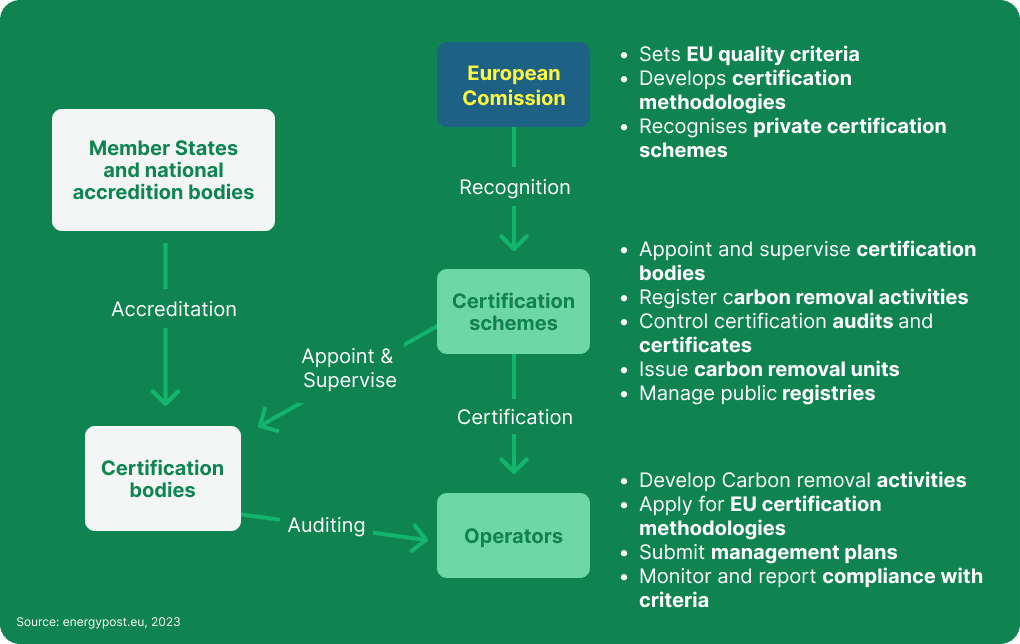
How is Tree.ly preparing for compliance with the Carbon Removals and Carbon Farming Regulation?
7/30/2024
|

Moritz Lutz

Background
The Carbon Removals and Carbon Farming Regulation (CRCF), is a landmark piece of legislation that will regulate the European voluntary carbon market (VCM) in concert with the Green Claims Directive and the Directive on empowering consumers for the green transition.
The European Commission will develop methodologies for a range of carbon removal and carbon farming activities and recognise certification schemes via delegated acts. This includes tech-based solutions like direct air capture, but also nature-based solutions like the forestry projects that Tree.ly develops. The CRCF, once operational, is intended to become a seal of quality that gives carbon buyers access to high-integrity carbon credits and at the same time enables operators (for example forest owners, farmers or project developers) to access private financing to implement climate-friendly practices and contribute to maintaining and enhancing the terrestrial carbon sink of the Union.
We do not expect the methodologies for forestry projects to be finalised before 2028-2030. This means that between now and then, all European project developers and forest owners are left with regulatory uncertainty until methodology drafts are published. Tree.ly is at the forefront of an initiative to prepare forest owners for compliance with CRCF to mitigate this uncertainty and to drive urgent action to address the climate emergency.
Known CRCF requirements and proactive compliance efforts by Tree.ly
While the principles of the CRCF Regulation are clearly set out in the provisional agreement, the important details of how certification schemes will function and what the methodologies will look like remain unclear. That being said, the provisional agreement and documents released by the European Commission contain pointers to existing EU regulation, such as the EU Renewable Energy Directive and the Taxonomy Regulation. Using these inputs, along with emerging international best practices, Tree.ly is collaborating on establishing an independent European certification scheme for forestry projects
Certification schemes
The certification process will be modelled on the EU Renewable Energy Directive. This means that the Commission will recognise private certification schemes who certify operators, based on the minimum sustainability criteria set out by the regulation.
By separating the certification scheme from the operator, which is not currently common practice among European project developers, European forestry projects will begin to operate according to international standards as well as CRCF requirements.
 Figure 1: Working principle of the CRCF certification system
Figure 1: Working principle of the CRCF certification system
Methodology
Anticipating the specific contents of forestry-related methodologies is difficult. What is known is that the minimum sustainability requirements of CRCF will build on the technical screening criteria of the EU Taxonomy Regulation, as well as the ‘do no significant harm’ principle of that regulation. For forestry projects, this means that – depending on the project type – they should be oriented to fulfil the technical screening criteria for afforestation, rehabilitation and restoration of forests after damages (reforestation), forest management or conservation forestry.
Additionally, the methodologies used by Tree.ly will be adapted to comply with international standards.
So what does this mean?
We are looking forward to the entry into force of the CRCF Regulation and believe that it has the potential to transform land use in the EU. We also welcome the inclusion of emissions reductions, as they are crucial to flattening the curve while we continue global efforts to reduce emissions and enhance removals.
We are collaborating with other players in the ecosystem to agree on quality markers in forestry projects and to launch a forestry standard for Europe.

